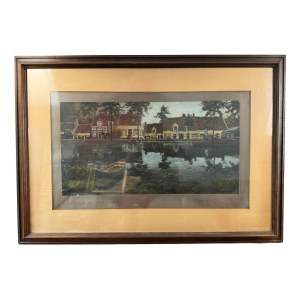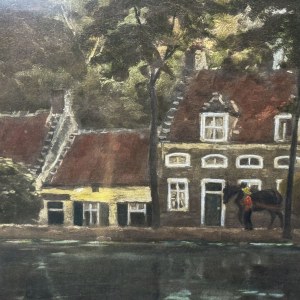Ambrose Benson
Milan 1495 - 1550 Flanders/Belgium
Adoration of the Child
Around 1525/35
Oil on oak panel
101 x 77.5 cm (with frame 115 x 93 cm)
This magnificent Christmas painting was produced in the workshop of Ambrosius Benson in oil on oak panel. Benson was active in Bruges between 1518 and 1550 and painted in the style of the Flemish masters of Old Netherlandish painting. He did not usually sign his works, as in this case, but it can be securely assigned to his oeuvre due to typical characteristics. The religious work was either commissioned by the church or, in this case due to its size, painted as a private devotional picture. In terms of composition and individual elements, it is very similar to the Nativity exhibited in the State Hermitage in St. Petersburg.
The Holy Family, consisting of Mary, Joseph and Jesus as an infant, occupies two thirds of the picture space and is constructed pyramidally: Mary and Joseph kneel in a reverent posture, flanking the child. He lies on a cloth in a manger filled with straw, which is also shown as a bundle in the foreground. An ox and donkey behind the child complete the group and locate the depiction in a stable. The walls made of stone blocks as well as the wooden ceiling appear rather fragile and ruinous; vegetation has also made its way through the stone bricks. In the background, a large window provides a view of a hilly landscape populated by sheep. Atmospheric lights in the opening in the sky between the clouds direct the view into the distance, while the earthly city walls suggest that the figures are staged in nature outside an urban environment. A younger and an older shepherd stand behind the window and look out at the action, mirroring the viewer. Behind them, an angel could even be seen silhouetted in white outlines, just announcing the good news that the Messiah has been born. Particularly exciting is also the group of six angels flying down from the upper left corner - from heavenly spheres - and expressing their homage in various gestures through folded or raised hands. The gazes of all the figures shown are directed towards the little child in the manger, whereby the relationship of gaze between mother and child is particularly emphasised, not least by the suggested halo of Mary and Jesus. The typical Flemish bonnet transports the action into a contemporary context.
A particularly impressive example for comparison is the painting of the same subject in the Hermitage: not only the arrangement of the Holy Family is identical, but also the position and gestures of the descending host of angels and the child. The view of a hilly landscape in the right half of the picture is also similar; however, here four shepherds step closer to the action; the central family no longer occupies more than half of the scene, which this time is set in a more populated city and ancient ruined landscape. This is almost certainly due to different commissions: the wealth of the commercial metropolises, such as the Flemish city of Bruges, where the artist worked, meant that the rich patricians now also acted as important patrons of the arts. The stage-like scene of a ruinous temple landscape in the Hermitage goes back to the concept of the rudimentary primitive hut (man's first dwelling), which was readily replaced by ruins from the late 15th century onwards. However, in the case of the presented painting, the painter wanted to create an atmosphere in which poverty and simplicity are better displayed, which also emphasises the intimate togetherness and piety, especially in combination with the high degree of naturalism. The transition from the late Gothic to the Renaissance is particularly well-staged here: symbolic colours in a medieval manner, such as the bright red of Joseph's robe, could allude to the future Passion of Christ. The rich drapery and elongated proportions of the figures also refer to the late Gothic tradition. Here, special reference should be made to the comparison with Benson's painting "Rest on the Flight into Egypt" in the Groenigemuseum, since here both the bright red colouring of the cloak and the physiognomy of the child are identical. Furthermore, in the painting described, Mary is seen wearing an embroidered dress and a mantle richly decorated with brocade borders, which indicate her future position as Queen of Heaven. The same brocade-lined mantle in elaborate drapery can be seen in the Nativity scene in the Yale University Art Gallery. Here, the arrangement of the Holy Family, the position of the child and the white cloth draped underneath are all the same. What is particularly impressive in the presented painting, however, is the new, precise observation of nature, for example the plants sprouting from the walls or the individual stalks that have detached themselves from the bale of straw. A detailed material surface characterisation and plasticity is shown especially in the woven basket, which is present here (and also in the mentioned comparative examples) and filled with wrapping cloths. This is probably a characteristic feature of the birth scenes of Jesus executed by Benson. This universal formal language of Early Netherlandish painting was taken up and varied again and again by Benson in the course of his artistic activity in order to express a profound religiosity which, although still using late Gothic symbolic features, was already rooted in the naturalistic tradition of the Renaissance.
Cf:
St. Petersburg State Hermitage, "The Adoration of the Child"
Groenigemuseum, Bruges "Rest on the Flight to Egypt"
Yale University, New York, "Nativity"
Ostatnio oglądane
Zaloguj się aby zobaczyć listę pozycji
Ulubione
Zaloguj się aby zobaczyć listę pozycji


















